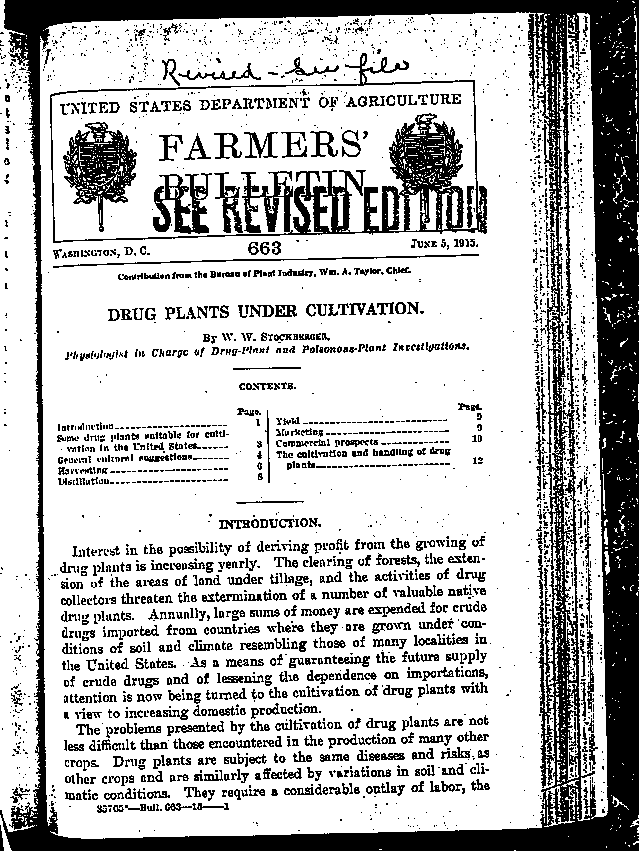Jim Finnel
Fallen Cannabis Warrior & Ex News Moderator
USDA Farmers’ Bulletin:
June 5, 1915
DRUG PLANTS UNDER CULTIVATION
June 5, 1915
DRUG PLANTS UNDER CULTIVATION
By W. W. Stockberger
Physiologist in Charge of Drug-Plant and Poisonous-Plant Investications
The cultivation and handling of drug plants: Cannabis
The drug cannabis or Indian hemp (Cannabis sativa), consists of the dried flowering tops of the female plants. It grows well over a considerable portion of the United States, but the production of the active principle of this plant is believed to be favored by a warm climate. For drug purposes, therefore, this crop appears to be adapted to the Southern rather than to the Northern States.
Cannabis is propagated from seeds, which should be planted in the spring as soon as conditions are suitable, in well-prepared sandy or clayey loam at a depth of about an inch in rows 5 or 6 feet apart. The seeds may be dropped every 2 or 3 inches in the row or planted in hills about a foot apart in the row, 6 to 10 seeds being dropped into each hill. Two or three pounds of seed per acre should give a good stand. About half the seeds will produce male plants, which must be removed before their flowers mature; otherwise, the female plants will set seed, thereby diminishing their value as a drug. The male plants can be recognized with certainty only by the presence of stamens in their flowers.
Ordinary stable or barnyard manure plowed in deeply is better for use as a fertilizer than commercial preparations and may be safely applied at the rate of 20 tons per acre. However, good results may be obtained with commercial fertilizers, such as are used for truck crops and potatoes, when cultivated in between the rows at the rate of 500 or 600 pounds per acre.
When the female plants reach maturity, a sticky resin forms on the heavy compact flower clusters, and harvesting may then be begun. The tops of the plants comprising the flower clusters are cut and carefully dried in the shade to preserve the green color as far as possible. Drying can best be done, especially in damp weather, by the use of artificial heat, not to exceed 140 deg F.
Returns from experimental areas indicate that yields of 400 to 500 pounds of dried tops per acre may be expected under good conditions. Although some American-grown cannabis is found in the crude-drug trade, a definite market for this product is not yet established. Those who contemplate the commercial production of this crop should therefore carefully investigate market possibilities before making any extensive plantings

Source: Cannabis Therapy Institutue - Medical Cannabis (Marijuana) Research, Education and Advocacy in Colorado


